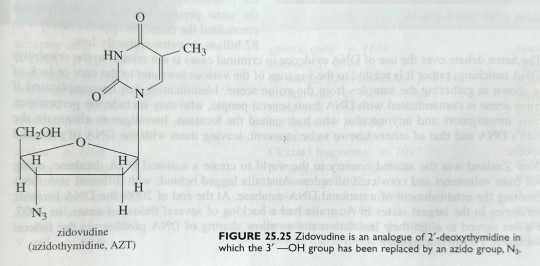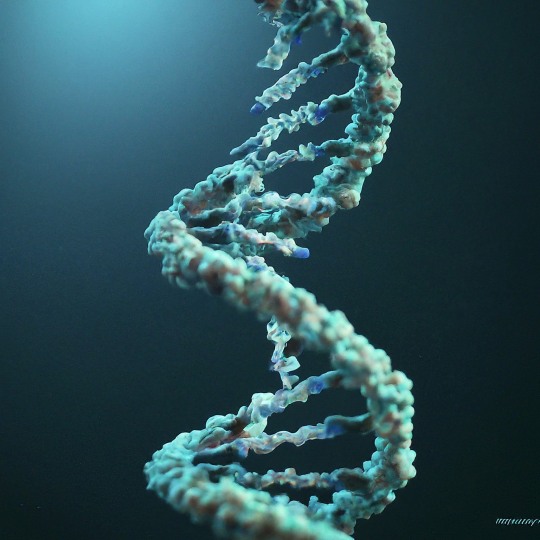#reverse transcriptase
Explore tagged Tumblr posts
Text

TSRNOSS, p 514.
#human blood#alkalinity#Tibet#lightning strike#evolution of human height#diving mammals#bradycardia#bubble formation#proton radiation#lung surfactant#radiation#lymphopenia#radiation exposure#hypertension#reverse transcriptase#bone cancer#radioactive isotopes#strontium#ultraviolet#erythema
0 notes
Text
One example of such a reverse transcriptase inhibitor is the compound AZT (see figure 25.22), which delays the progression from HIV infection to AIDS (acquired immune deficiency syndrome). (...) Perhaps the best known of the HIV-fighting viral antimetabolites is zidovudine (AZT), an analogue of deoxythymidine in which the 3'-OH has been replaced by an azido group, N3 (figure 25.25).

"Chemistry" 2e - Blackman, A., Bottle, S., Schmid, S., Mocerino, M., Wille, U.
#book quotes#chemistry#nonfiction#textbook#reverse transcriptase inhibitor#azt#zidovudine#azidothymine#hiv#aids#antimetabolites#antiviral#nitrogen
2 notes
·
View notes
Text
Pathogen assigned: Orthohepadnavirus hominoidei (Name based on ICTV standards)
Cause of hepatitis B, type of enveloped (partially) double stranded DNA virus

(Image from Wikipedia page)
Spread via: Sexual transmission, intravenous injection, crossing of the placental barrier
picture of a cute innocent baby animal "um this is who youre being mean to btw" thats not even true man youre a straight up vampire and you destroyed my village with your dark powers
#human pathogens#virus#gimmick blog#Apparently a part of the genome isn't double stranded?#It also has reverse transcriptase despite being a DNA virus#Cool little dude
68K notes
·
View notes
Text
Antiviral Drugs: The Frontlines of Disease Prevention and Treatment

What are Antiviral Drugs? Antiviral drugs are medications for treating infections caused by viruses. Unlike antibiotics, which work against bacteria, antiviral drugs target virus infections such as influenza, hepatitis, herpes, and HIV/AIDS. These drugs do not cure viral infections but may help control symptoms and reduce the ability of viruses to multiply in the body. How do Antiviral Drugs Work? There are several ways that antiviral drugs work to fight viral infections: - Interfering with Viral Attachment: Antiviral Drugs is prevent viruses from attaching to and entering host cells in the body. This approach blocks the initial stage of viral infection. - Interrupting Viral Replication: Many antiviral medications interfere with the replication or reproduction of viruses already inside host cells. They target viral enzymes or proteins essential for viral replication and stop the virus from multiplying. - Incorporating Into Viral DNA/RNA: Some drugs incorporate themselves into the developing viral DNA or RNA during replication. This incorporation results in structural defects in the new viral particles that render them unable to function or infect other cells. - Mimicking Building Blocks of Viruses: Certain antiviral drugs resemble the natural building blocks viruses use during replication. The drugs get incorporated into new viral particles instead, resulting in non-functional or dead viral offspring. The Development of Antiviral Resistance Like bacteria, viruses can mutate and evolve resistance to medications over time. Repeated or prolonged use of antiviral drugs increases the likelihood that drug-resistant virus strains will emerge and spread. Some common mechanisms of antiviral resistance include: - Mutations in Viral Target Sites: Changes in the viral genes or proteins targeted by drugs can prevent the drugs from binding or having an effect. - Alterations in Cellular Target Sites: Mutations in host cell genes involved in viral infection processes may help viruses evade drug effects. - Enhanced Drug Efflux: Mutant viruses may efflux or pump out antiviral drugs more quickly, decreasing drug levels inside infected cells. - Enzymatic Drug Inactivation: Viruses resistant to some drugs produce enzymes that chemically inactivate the medications before they can take effect. To counter resistance, combination antiviral therapies targeting multiple parts of the viral life cycle are often prescribed. Constant monitoring of resistance remains important for treatment effectiveness. Newer antiviral medications continue being developed to stay ahead of evolving viral threats. The Clinical Significance of Antiviral Drugs
Discovery of effective antiviral drugs has transformed the medical management of many once-devastating viral illnesses: - Influenza: Neuraminidase inhibitor drugs like oseltamivir reduce flu severity and duration when taken early in infection. They helped minimise deaths during pandemics. - Hepatitis: Nucleoside and nucleotide analogues halt hepatitis B and C virus replication, are curative in many cases and prevent life-threatening complications like cirrhosis or liver cancer. - Herpes: Oral antivirals inhibit herpes simplex and varicella zoster virus replication, preventing recurrent outbreaks or severe infection in high-risk individuals. - HIV/AIDS: Potent combination antiretroviral therapy controls HIV replication and restores immune function, transforming AIDS from a fatal disease to a manageable chronic condition. - Ebola: Drugs like remdesivir proved effective against the recent Ebola outbreaks and research continues developing therapies before the next epidemic arises.
Get more insights on, Antiviral Drugs
For Deeper Insights, Find the Report in the Language that You want.
Japanese
About Author:
Vaagisha brings over three years of expertise as a content editor in the market research domain. Originally a creative writer, she discovered her passion for editing, combining her flair for writing with a meticulous eye for detail. Her ability to craft and refine compelling content makes her an invaluable asset in delivering polished and engaging write-ups.
(LinkedIn: https://www.linkedin.com/in/vaagisha-singh-8080b91)
#Coherent Market Insights#Combination Therapies#Increasing R&D Activities#Reverse Transcriptase Inhibitors#Hospital Pharmacies
1 note
·
View note
Text
https://app.socie.com.br/read-blog/133443_reverse-transcriptase-market-size-share-and-forecast-2031.html

Reverse Transcriptase Market Size, Share and Forecast 2031
#Reverse Transcriptase Market#Reverse Transcriptase Market Scope#Reverse Transcriptase Market Size#Reverse Transcriptase Market Report
0 notes
Text
Development and validation of ultraviolet spectrophotometric methods for lamivudine and zidovudine quantification in dissolution test
Article published in J. Pharm. Pharmacogn. Res., vol. 10, no. 5, pp. 847-856, September-October 2022. DOI: https://doi.org/10.56499/jppres22.1433_10.5.847 Enma Perez-Chauca1*, Pedro M. Alva-Plasencia2, Humberto Gomes Ferraz3 1Unidad de Posgrado en Farmacia y Bioquímica, Facultad de Farmacia y Bioquímica, Universidad Nacional de Trujillo, Trujillo, 13011, Perú. 2Departamento de Farmacotecnia,…

View On WordPress
0 notes
Text
Context:


#ada weblog tag#//''hiding info inside dna'' is a popular idea in like spy or scifi tales but i've always found it flawed#//it's been done before and there is a reason it's of interest - you can store a lot of data in a tiny space#//but i mean. there's just so much that can go wrong - right??#//retrovirus waltzing into the cytoplasm with some reverse transcriptase: EY! fork yer lyse. bing bong 🐦🧬
12 notes
·
View notes
Text
Reference preserved in our archive (Daily updates!)
This study shows the importance of masking and distancing not just on covid, but all common respiratory infections. Even if we're wrong about covid, we're right about 7 other diseases. Mask up. Keep everyone more healthy.
Abstract Background. Microbiologic confirmation of respiratory tract infections gained importance during the coronavirus disease 2019 (COVID-19) pandemic. This study retrospectively evaluated seasonal distribution, clinical presentation, and complications of respiratory viral infections (RVIs) other than COVID-19 in children with cancer during and after the pandemic lockdown.
Methods. Two hundred and sixty-five inpatient and outpatient RVI episodes in 219 pediatric cancer patients confirmed by multiplex reverse transcriptase polymerase chain reaction (RT-PCR) panels from 13 centers were enrolled.
Results. Eighty-six (32.5%) of the total 265 episodes occurred in 16 months corresponding to the lockdowns in Türkiye, and the remaining 67.5% in 10 months thereafter. Human rhinovirus/enterovirus (hRE) (48.3%) was the most common agent detected during and after lockdown. Parainfluenza virus (PIV) (23.0%), influenza virus (9.8%), and respiratory syncytial virus (RSV) (9.1%) were the other common agents. The 28.7% of episodes were lower respiratory tract infections (LRTIs), and complications and mortality were higher than upper respiratory tract infections (URTIs) (25.0% vs 5.3%). Bacteremia was identified in 11.5% of culture-drawn episodes. Treatment delay in one-third and death within four weeks after RVI in 4.9% of episodes were observed.
Conclusion. During the pandemic, fewer episodes of RVIs occurred during the lockdown period. Respiratory viruses may cause complications, delays in treatment, and even death in children with cancer. Therefore, increased awareness of RVIs and rapid detection of respiratory viruses will benefit the prevention and, in some cases, abrupt supportive and some antiviral treatment of RVI in children with cancer.
#mask up#covid#pandemic#wear a mask#public health#covid 19#wear a respirator#still coviding#coronavirus#sars cov 2#influenza#common cold#RSV
39 notes
·
View notes
Text
A Scientific Explanation of the Fraud of RT-PCR Testing for COVID-19
Corinne Michels
Nov 05, 2024
“The COVID-19 PCR tests were a fraud.” You have heard this before, but is it true or just more hype? Read this report and decide for yourself. It explains the fundamentals of the RT-PCR (Reverse Transcriptase - Polymerase Chain Reaction) test kits for those who want to understand the facts. Do not expect an easy read. For starters, you will need to familiarize yourself with the basic structure of DNA. Understanding how misinterpretation of the RT-PCR test results was used to create the COVID-19 pandemic will be your reward. You will be immunized against future efforts to create fear and societal discord. Rest assured; they will try again!
A serious flu-like respiratory disease began to spread in early Fall 2019 with Wuhan, China, as “ground zero.” By December, worldwide spread of the disease was underway. Images of hapless pedestrians suddenly falling dead in the streets; overwhelmed hospitals in Lombardy, Italy; government-imposed lockdowns; and nonstop coverage of worldwide COVID deaths fanned the flames of fear surrounding this unknown disease. It was not enough to be symptom-free. People demanded the development of a test to detect silent carriers of the infectious agent.
Only the genome sequence of SARS-CoV-2 was known at the time, and the only available testing method used polymerase chain reaction, a.k.a. PCR. Despite many known contraindications, RT-PCR widespread testing for COVID-19 began. According to Dr. Trish M. Perl, an epidemiologist at Johns Hopkins and past president of the Society of Health Care Epidemiologists of America, blind faith in the results of technically complex molecular tests results in “pseudo-epidemics.” [https://www.nytimes.com/2007/01/22/health/22whoop.html] The COVID-19 pandemic was one of those.
14 notes
·
View notes
Text

me who did 2 articles and a seminar on retroviruses trying to remember what the fuck is an reverse transcriptase
8 notes
·
View notes
Text
Retroviruses got me fucked up
@moosemonstrous are u ready for a dissertation? I hope so.
people who followed me for art I'm so sorry
ALRIGHT so we're gonna cover a couple areas.
General information about retroviruses.
Details about The Corruption and theories about how it works inside the body.
SPECIFICALLY ROBBIES viral weird shit. Cause what he has going on is even more fucked up than normal fucked up. Fucked up squared.
Me ranting about skin necrosis and why I shouldn't have just. Thown it in there because I thought it would look fucky wucky.
GENERAL INFORMATION ABOUT RETROVIRUSES:
As most people know, a virus is a cell that enters the body of a host and alters its DNA to turn that hosts cells into virus making factories. This is what allows viruses to duplicate and spread through the body so quickly. But whats that? 'What makes retroviruses different from other viruses?' I hear you asking? WELL EXCELLENT QUESTION THATS A PERFECT PLACE TO START. A retrovirus is different because its method of self duplication involves an enzyme called reverse transcriptase. This makes retroviral infection PERMANENT. Even if the virus is defeated by the immune system, those changes stick around. The phrasing used was 'ipso facto mutagenic' meaning 'by the fact itself/inevitable'.
...Which is kinda metal honestly I want it on a tee shirt (definetly not thinking of Amadeus saying that to Robbie as he tries his best to explain theres no way to undo whats going on with him. nahhhh angst don't got a hold on me like that [<- vibrating])
'Ohhh but if those genetic changes never go away, doesn't that mean that those viruses will get passed on through peoples children?' ASKING SUCH GOOD QUESTIONS TODAY MY MUTUAL BECAUSE THE ANSWER IS YES. Once a retrovirus codes itself into a hosts gnome, its called a provirus (pro gamer move right there) Fun (not fun) fact around 8% of the human gnome is made of proviruses. These are called endogenous viruses, and for the most part they just kinda sit there and stay dormant. TERRIFYINGLY, other viral infections can trigger these endogenous viruses out of dormancy. As for what actually causes a provirus to go dormant uhhhhhhhh I dunno. Couldn't find an answer in my research someone make me look stupid with an answer please because I wanna know.
Ok now lets talk about the immune system a little bit. There are a few different kind of cells at work (hehehehehe) that help to fight viruses and other infections in the body. The first are Cytotoxic T cells or Killer T Cells. These are the cells that directly destroy cells displaying genetic patterns they recognize as bad. Next we have CD+4 Cells (Helper T Cells) which act as a library that stores information about how to identify an infected cell, and shares that information with other Killer T cells once one figures it out. Then there are the Regulatory T cells which suppress your immune responses to maintain homeostasis. They're what (USUALLY) stops your immune system from killing you while trying to clear a virus. Last there are Macrophage. CELLS AT WORK MAID MILFS- I mean cells that clear the debris that remain after the Killer T Cells are done destroying them.
Retroviruses have two primary ways of either side-stepping the immune system or just. Overwhelming it completely. Acutely transforming retroviruses do just that. They reproduce too quickly for Killer T cells to destroy them all and exhaust the system. The second type are called Non Acute Retroviruses. They camouflage viral particles as immune cells to suppress the immune system. For example, HLTV-1 is a retrovirus that disguises itself as a Regulatory T cell to artificially suppress the immune response thats trying to kill it.
HTLV-1 is really interesting because most of the time patients are asymptomatic, but 5% can graduate to HTLV-1 associated myelopathy/tropical spastic paraparesis, which affects the spinal cord and white matter of the central nervous system. This usually results in the weakening of lower extremities and sometimes total bowl/bladder control loss. It suckkssssss (but is also a retrovirus that affects the central nervous system so were circling back to it later 👀).
SPECULATION ABOUT THE CORRUPTION:
I've said previously that The Corruption has potential for a retrovirus that affects the central nervous system by degrading the brains ability to regulate muscular contraction, while also pumping out a ton of cortisol and adrenaline to encourage 'hysterical strength'.
Now I did a little more research about Hypoglycemia and combined with the nerve damage people would likely die from cardiac arrhythmia, which is a life threatening kind of ventricular fibrillation. Long and short, it means their hearts don't have the proper energy and stimulation to keep beating properly, so they stop beating in sync. This results in insufficient blood flow to vital areas like the brain, and combined with the inadequate blood sugar, this would result in very fast brain death.
Let's talk about the immune systems response to this Corruption retrovirus. We would most likely see lots of inflammation, and with the main focus being on nerve cell this would probably result in meningitis, which is inflammation of the tissue surrounding the brain and spinal cord. If left untreated this could result in a coma and then death. So we're seeing a SHIT ton of pressure on the brain and central nervous system. Which is like. VERY BAD for a person. We're talking brain death very very fast.
As for how the virus would target the nervous system directly we could look to real world examples like rabies (ahhhh rabies. can never get away from you). The virus would attach to nicotinic acetylcholine receptors, which are what turns chemical signals into electrical signals in your nerves. It would then spread through the axons of the central nervous system and eventually reach the brain. We could also pull a rabies with 'once you see symptoms it's too late' which I, personally, find fucking terrifying.
In terms of the virus losing its effectiveness once outside the body of a Demon/Kaiju we would likely need to look at the anatomy of a retrovirus itself. The outermost area is composed of envelope spikes, which tell the cell to let it in. After that is an envelope protein which plays an important role in complete virus particle (virion) assembly. Theres then a protein shell that contains reverse transcriptase and the RNA gnome that it will use to recode a host cell. If this virus evolved to survive in an environment that is always warm (hell. lol. lmao.) it might not be prepared to deal with these colder temperatures in our world. This could result in damage to the protective protein barriers and cause damage to the real important parts, the RNA and reverse transcriptase. This would mean that the virus would not be near as effective as a fully intact retrovirus cell.
The Corruption could be an endogenous virus thats embedded into the Demon/Kaiju gnome that wouldn't affect them, but would absolutely affect us because we haven't seen them before.
ROBBIES WEIRD FUCKSHIT:
alright guys this is where we put the FI into SCIFI cause your about to read a whole lot of nonsense sentences.
Robbie. Robbie is fucking WEIRD in EVERY universe and this shit is absolutely not different. Him being exposed to that previously mentioned damaged version of the virus from a young age might not give him true immunity but it would give him SOMETHING to work with. His immune system is at least slightly familiar with it and at this point whatever damaged version he came into contact with has already established itself as a provirus in him.
The Corruption thats established itself in The Charger is different.
Like I mentioned in my first diagram, I think there was a chemical reaction that stabilized the corrosive aspect of The Corruption, but this reaction would also have had an effect on the retroviral properties of the Demon/Kaiju material. ESPECIALLY when we add Eli into the mix.
Now, I think generally the amount of radiation that these viruses would be exposed to would kill them (if you believe viruses are alive. there is some MEGA debate going on about that). But if the corruption was just stabilized/hardened on the outside and left squishy and organic on the inside, that would successfully protect everything. And whats that organic squishyness on the inside? EXCELLENT QUESTION AGAIN. If Eli died while inside The Charger then it's not a stretch to think his DNA would have been incorporated and stored via through the natural processes of the retrovirus as a provirus. And so you end up with the genetic mixture of a horrifying creature capable of heinous acts, and a Demon/Kaiju. WITH retroviral properties. Dear god.
Robbie would get exposed to this the very first time he enters the Charger. Because of his semi-immunity + genetic relation to Eli he would likely be able to overcome the more meatsuit damaging aspects of this mixture and just get right through the genome editing without much fuss from his immune system. We would still have a certain degree of damage to his nervous system which allows for that change in strength that would occur in usual examples of the virus (maybe some added aggression from mild influence in his amygdala), but not to a deadly degree. Honestly this shit would barely classify as a virus its just. A nightmare mutagen at this point. So while some of his gnome would remain fairly the same, a good 30% to 50% is megafucked.
Changing Robbies genotype to this degree will naturally result in a change to his phenotype! For the sake of fun were gonna ignore stem cells and their weirdness (for now. I just need to stew on it a little longer and I can make up some bullshit I'm sure). The damage his muscles would experience from less regulated signals would mean they experience muscle tears and subsequent muscle growth. For usual muscle damage from exercise this takes a few days, so if we wanted to keep with that timeline it could be interesting to introduce some minorly sped up healing. That would also be fun for reactivating the growth plates in his bones to allow him to become bigger and taller overall (boring body horror my beloved @cicada-candy that term is never leaving).
THEN you can get into some of the fucky wuckier traits like tapetum lucidum and TEEF. TEEEEEEFFFF. The teeth in particular could go a few different ways. You could just have growth and development of the canines resume until they become elongated and more prominant. OR. You could replace the teeth with bony protrusions from the skull that would push out the original canines and grow in their place. Because of the time it takes for bones to heal your looking at this happening around 20 weeks out. Literally any fun trait you want to take from Demon/Kaiju could apply here.
The most important part would be the nerve bundles on his spine that would be used to bluetooth to The Charger (<- this is a nonsense sentence. I am aware of this). These would provide faster communication with the charger and (theoretically) more intuitive movement, while also allowing him to eventually controlling the charger from the outside. Please note that this would cause EXTREME STRESS to his nervous system. It would be like a person trying to flex a muscle the size of another person for the first time. LEARNING PROCESS. TAKE IT SLOW OR HAVE AN ANEURYSM.
Which leads me to the youtuber apology part of this.
WHY I SHOULDNT HAVE JUMPED TO SKIN NECROSIS:
Skin necrosis is a result of the mass death of skin cells that is furthered by the damage to blood cells. This usually results in a blackened, leathery texture to the necrosed skin. I SHOULD HAVE NEVER EVEN MENTIONED THIS.
What I SHOULD have done is said 'hmm ah yes it would make more sense for some protective covering over these nerve concentrations to either come from materials in Robbies body or to mutate into the skin of the Demon/Kaiju'. This is why we do sufficient research before getting back on our bullshit, wazz (mental note mental note mental note mental note).
I am quite partial to the idea of that stronger/thicker Demon skin/armor growing under Robbies skin and it just itches and burns until he cant ignore it anymore. And then he can pull off. Whatever skin is on the top of it. HEHHEHEHOHOHOHO DELICOUS MENTAL IMAGE of him panicking because he just wanted to scratch his back but now theres blood on his hands and skin sloughing off and dear fucking lord how did he get to this point in his life (<- I daydream about normal things guys don't worry. very average things).
ANYWAY uhhhh if you made it this far I love you. Legit. Have a cookie. Take a nap. Have a happy holidaze <3.
#Also messing with the idea of the chargers stabalized corruption spreading so it becomes more biomechanical than just mechanical#so as that information spreads it updates robbie every time he pilots the charger. then you can get fun stuff like scars showing up on him#<- where the Charger has been damaged#FUN SHIT LIKE THE CHARGER BEING ABLE TO ACTUALLY OPEN ITS FACE PLATE LIKE A MOUTH AND BITE A DEMON#bite scratch bite bite bite bite bite#I love him and so he must suffer#ghost rider pacific rim au#ghost rider#robbie reyes#speculative biology#this is two thousand words. how did i end up here
45 notes
·
View notes
Video
tumblr
DISCLAIMER: Please do your own research and come to your own conclusions.
Dr Peter McCullough - Vaccine Disaster - This Messenger RNA Looks Like Its Permanent.
The 3 prime and 5 prime caps at the end, the Nucleoside Analogues (mRNA) are NOT digested and these enzymes actually ENHANCE Reverse Transcriptase. This means that there is Synthetic DNA being copied and being produced over and over.
This synthetic DNA Code is permanently transcribed into your DNA. Your DNA has been Modified.
DISCLAIMER: Please do your own research and come to your own conclusions.
198 notes
·
View notes
Text
Abstract
Preclinical studies of COVID-19 mRNA vaccine BNT162b2, developed by Pfizer and BioNTech, showed reversible hepatic effects in animals that received the BNT162b2 injection. Furthermore, a recent study showed that SARS-CoV-2 RNA can be reverse-transcribed and integrated into the genome of human cells. In this study, we investigated the effect of BNT162b2 on the human liver cell line Huh7 in vitro. Huh7 cells were exposed to BNT162b2, and quantitative PCR was performed on RNA extracted from the cells. We detected high levels of BNT162b2 in Huh7 cells and changes in gene expression of long interspersed nuclear element-1 (LINE-1), which is an endogenous reverse transcriptase. Immunohistochemistry using antibody binding to LINE-1 open reading frame-1 RNA-binding protein (ORFp1) on Huh7 cells treated with BNT162b2 indicated increased nucleus distribution of LINE-1. PCR on genomic DNA of Huh7 cells exposed to BNT162b2 amplified the DNA sequence unique to BNT162b2. Our results indicate a fast up-take of BNT162b2 into human liver cell line Huh7, leading to changes in LINE-1 expression and distribution. We also show that BNT162b2 mRNA is reverse transcribed intracellularly into DNA in as fast as 6 h upon BNT162b2 exposure.
3 notes
·
View notes
Text
Note Cards (December 2023)
1st Class Lever
2/3rd Down Femoral Shaft Diagram
2nd Law of Motion
Allosteric Fatty Acid Control
Antidiuretic Hormone
Arginase Disorder
Body Lever System
Bone Functions
Chemotherapeutic Mechanisms
Conservation Laws in Physics
Cytosol
Estuary
Extrasutural Bones
Genetic Transformation
Generalized vs Specialized Transduction
Growth Hormone
Hamstrings
Human Papillomavirus 16
Interpreting Bowel Sounds
Long Head of Biceps Femoris OIA
Long Head of Triceps Brachii
Metacarpal 1 - Dorsal
Nucleoside Reverse Transcriptase Inhibitors
Phage T4 Assembly
Physico-
Radius Upper Midshaft Diagram
Re
Rene-Robert Cavelier
Stylohyoid OIA
Submandibular Ganglion
Superior
Terminal Cisternae
Uses of Linezolid
Yucca faxoniana
Zhemaichu Horse
Zygomaticoorbital Foramen
#studyblr#notes#my notes#medblr#masterlist#study masterlist#masterlists#studyblr masterlists#master lists#studyblr master lists#study master lists#botany#biology#biology study guide#mcat#mcat study guide#mcat masterlists#biology masterlists#physics#study guides#study guide#notes masterlist#notes master lists#equine science#science#scienceblr#sciblr#science master list#science masterlists#science master lists
12 notes
·
View notes
Text

RNA: The Dynamic Molecule Driving Life's Diversity
DNA, the blueprint of life, often steals the spotlight when it comes to genetics. But lurking in its shadow is another crucial molecule, RNA (Ribonucleic Acid), playing a pivotal role in the symphony of life. More than just a passive messenger, RNA boasts a vibrant history and holds exciting potential for the future. Let's embark on a journey to unveil the world of RNA, exploring its captivating story and why it deserves your attention.
The story of RNA's discovery began in 1860 when Friedrich Miescher isolated a mysterious "nuclein" from white blood cells. However, it wasn't until the 1950s that James Watson and Francis Crick, alongside Rosalind Franklin (whose contributions were initially overlooked), unraveled the structure of DNA, relegating RNA to a supporting role as a mere messenger molecule. But the plot thickened in the 1960s when researchers like Howard Temin and David Baltimore stumbled upon reverse transcriptase, an enzyme that could convert RNA into DNA, challenging the long-held "central dogma" of DNA being the sole source of genetic information. This discovery opened the door to a whole new understanding of RNA's diverse capabilities.
The Many Faces of RNA
But RNA isn't just a protein puppet master. There are different types of RNA, each with unique jobs:
Messenger RNA (mRNA): Delivers the protein-making message. Transfer RNA (tRNA): Brings the amino acids, the building blocks of proteins, to the party. Ribosomal RNA (rRNA): The foreman of the ribosome factory, making sure everything runs smoothly. Non-coding RNA (ncRNA): A diverse bunch with various roles, from regulating genes to fighting viruses.
The true game-changer came in the early 2000s. Scientists stumbled upon a vast class of non-coding RNAs that don't code for proteins but have diverse and crucial functions. microRNAs (miRNAs), for example, regulate gene expression by silencing specific genes, while long non-coding RNAs (lncRNAs) control various cellular processes like development and disease. This discovery shattered the dogma that only protein-coding genes mattered, highlighting the crucial roles played by non-coding RNAs.
This newfound understanding of RNA's potential has ignited a revolution in medicine. Researchers are exploring RNA-based therapies for various diseases, from cancer and neurodegenerative disorders to viral infections. mRNA vaccines, like the ones used against COVID-19, harness the power of messenger RNA to deliver genetic instructions directly to cells, triggering immune responses. The future holds even more promise, with scientists exploring techniques like CRISPR-Cas9 to edit RNA and potentially treat genetic diseases.
New discoveries are constantly rewriting our understanding of this versatile molecule. Its adaptability and diverse roles make it a powerful tool for exploring the very essence of life, from evolution and development to disease and therapy. So, the next time you hear about genes, remember that RNA, the often-overlooked player, is just as crucial in shaping the tapestry of life. It's a story of constant evolution, unexpected discoveries, and immense potential, making RNA a molecule brimming with fascination and promise for the future.
#science sculpt#life science#science#molecular biology#biotechnology#biology#genetics#RNA#daily dose of science#dailyprompt#meaningful#scientific illustration#the glass scientists#microscopic world#microscopy#artists on tumblr#digital artist
12 notes
·
View notes
Text
https://theomnibuzz.com/reverse-transcriptase-market-size-share-and-forecast-2031/

Reverse Transcriptase Market Size, Share and Forecast 2031
#Reverse Transcriptase Market#Reverse Transcriptase Market Scope#Reverse Transcriptase Market Size#Reverse Transcriptase Market Report
0 notes